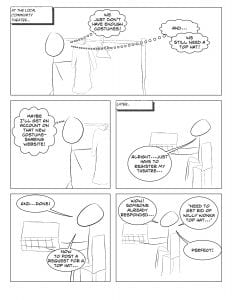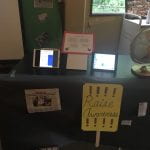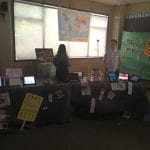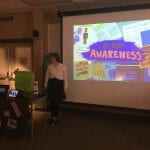You may remember reading my blog post last year about Blue Sky, and the exhibition that we did at the end of the year. Well, it’s June again, and we’ve just completed our final exhibition of Grade 9!
We started by creating a project. Now, the idea of this project was that it would solve a problem we had seen or experienced. This meant that before we could create this project, we had to go through a specific process first— the LAUNCH Process! The LAUNCH Process is a design cycle that helps people create anything, any invention. We documented our entire process using LAUNCH journals, then presented our projects with LAUNCH portfolios. To take you through my process, I want to take you through my LAUNCH portfolio, and every step I did along the way.
The first step of the process is L— Look, Listen, and Learn. The first thing I did during this stage was write some paragraphs about issues I cared about. These issues varied widely, from global warming to representation in media for LGBT youth, to costume budgets and availability for small community theatres. I decided to go forward with third issue— small community theatres having difficulties affording costumes for their productions. Then, I did some research on this topic. I checked out mtishows.com, which has a feature that lets theatres sell costumes. I realized that the problem with these costumes was that they were all for big shows, which a lot of small community theatres aren’t producing. I completed this section by creating a driving question for the rest of my project— HOW MIGHT WE create a simple, efficient way to trade, purchase, rent, and sell costumes for community theatre productions?
The next stage was A— Ask Questions. I created a chart for this section, detailing what I knew about the issue and what questions about the issue I needed answered to complete my project. This chart is called my Need-To-Know chart. I also created a timeline for my project during this stage.
The third stage is U— Understand the Problem or Process. To complete this stage, I did a lot of research. I interviewed Sherry Whitmore, a woman who worked as a costumer during the 2017 Deep Cove Christmas Pantomime, The Grand Old Duke of York.
‘…it was a huge piece of our costume budget on that one dress…then the other characters had to have…cheap costumes to make up for it.’
– Sherry Whitmore, Costumer
 She told me a lot about the process, including how costume shops can be way too expensive for community theatres. I also learned from her how the costume budget of the show was divided up. This pie chart was created with her input. As you can see, renting just one dress from a costume shop took up 20% of the budget.
She told me a lot about the process, including how costume shops can be way too expensive for community theatres. I also learned from her how the costume budget of the show was divided up. This pie chart was created with her input. As you can see, renting just one dress from a costume shop took up 20% of the budget.
 Next, it was time for N. This is the Navigate Ideas stage, and it’s when you come up with all of your ideas. I used the Post-It Notes app to write down all the ideas I came up with, then grouped them together into three categories— ways to Get Costumes, a Physical Location, and how to have Community Engagement. Then, I narrowed it down to a solid idea so I could move on to prototyping. This solid idea is an website where small theatres, including school theatres, can buy, sell, and trade costumes affordably between each other.
Next, it was time for N. This is the Navigate Ideas stage, and it’s when you come up with all of your ideas. I used the Post-It Notes app to write down all the ideas I came up with, then grouped them together into three categories— ways to Get Costumes, a Physical Location, and how to have Community Engagement. Then, I narrowed it down to a solid idea so I could move on to prototyping. This solid idea is an website where small theatres, including school theatres, can buy, sell, and trade costumes affordably between each other.
Then, it was time for prototyping! This section is C- Create A Prototype. First, I figured out what to prototype by looking at this website. Then, I created three rapid prototypes. Rapid Prototypes are just to get your ideas down, in many different forms.
I chose a storyboard, a skit, and a sketch/design of the website I wanted to create. The storyboard shows a situation where the website would be useful. The skit shows how a transaction would happen outside of the website, once an exchange has been established. Then, I moved onto live prototyping. This is when you create what you’ll actually show off, and get feedback from your client. Now, my client is Sherry, the costumer, so I showed her my website design and she gave me some feedback.
With that feedback, I was ready for the last stage, H— Highlight and Fix. I created several more prototypes based on the feedback I was given by my client. I created this website using Keynote, and made a few different drafts. Once I had my final draft, it was time to present at the exhibition!
At the exhibition, I worked with Amelia, Alex, Caleb, Malaika, Ben, and Angelo to fully transform our room. The theme of our room was ‘Awareness’ and more specifically, ‘Group Awareness.’ We decided we would decorate the room with things that raised awareness, such as newspaper clippings, protest signs, and globes. We were given half of the back room of the library, which we shared with ‘Individual Awareness.’ We also shared a food table with them. Many of the foods on this table were gluten-free or peanut-free, to raise awareness for the issues of people with allergies and celiac disease. We also had a scavenger hunt with trivia questions about each project, to raise awareness about each project.
I think this exhibition went really well. We truly transformed our room, and I’m really proud of my project. I think it has real-world uses that I would find really helpful. I’m also glad I was able to use the LAUNCH Process to create it!
Thanks for reading my blog post!





